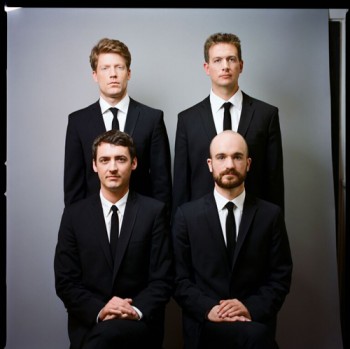by Mike Telin

Due to the Quartet’s touring schedule we were unable to arrange a live interview, although violinist Andrew Bulbrook graciously agreed to answer questions by e-mail.
Mike Telin : I hope the recent performances in London and Berlin went well.
Andrew Bulbrook: Thanks! We had a great time at the Barbican. Berlin is fun. It’s nice to be in a place where classical music is so central to the culture.
MT: Can you say a few words about each of the works on the Transformer Station program?
AB: Daníel Bjarnason wrote Stillshot for us, and we premiered it at the Broad Stage in Santa Monica last April. Daníel is a leading Icelandic composer and his profile is really on the rise. In this work he explores remembrance. It’s like someone looking back at images or memories of their life.
Benjamin Britten’s String Quartet No. 2 in C, Op. 36 is one of the great string quartets of the 20th century. The chaconne movement is particularly moving, and at 17 minutes it’s the emotional core of the work.
We have been exploring Beethoven’s string quartets at the Broad Stage this season, and we will be doing all of them over three seasons. His Quartet No. 12 in E-flat, Op. 127 is the first of the late quartets. Emotionally and structurally, it starts showing the full complexity of his late style.
MT: Why did you decide to place them on the same program? Obviously it’s more than all of their last names begin with ‘B.’
AB: Alliteration is nice isn’t it? There are timbral similarities between these works, and since we’re playing them in reverse chronological order, they show the string quartet in evolution from our time to the past.
MT: The quartet has enjoyed a fruitful professional relationship with composer Thomas Adès. Why has the partnership worked so well?
AB: We met Tom years ago in Los Angeles courtesy of the LA Phil. We had been studying his music for years before that meeting, and he really liked what we did with Arcadiana. From there, we did the piano quintet and then the latest quartet, The Four Quarters. We feel lucky that he has spent time with us working on his music. We’ve recorded with him, and this summer we will be performing at the Salzburg Festival with him as well. For us, his blend of tradition with the present is perfect.
MT: Can you talk a little bit about the Sadler’s Wells production with Adès that you are presenting at Lincoln Center’s White Lights Festival?
AB: We will play the piano quintet with Tom as pianist. Sadler’s Wells will be dancing to our live playing. We are excited to head to Lincoln Center right after our performance at the Cleveland Museum of Art.
Published on ClevelandClassical.com November 10, 2015.
Click here for a printable copy of this article



